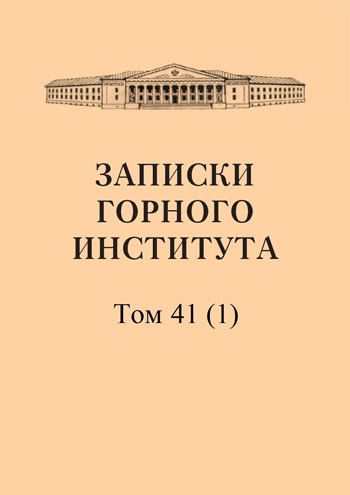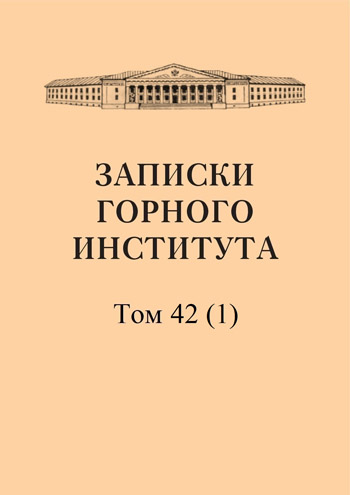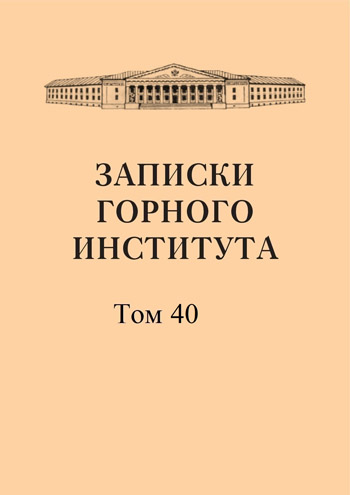-
Date submitted1958-07-23
-
Date accepted1958-09-30
-
Date published1959-07-29
Destruction of coals and rocks by water jets (Works of laboratories of the Leningrad Mining Institute)
- Authors:
- V. I. Gerontev
- L. P. Severin
The study of destruction of coals and rocks by water jet was carried out in four main directions: 1) the process of destruction of rocks and some artificial materials under the application of; impact and static loads and identification of factors determining the energy intensity of such destruction; 2) the structure and parameters of free high-pressure water jets; 3) the process and energy intensity of rock destruction by water jet; 4) mathematical interpretations of laboratory research data and production observations and development of the basics of engineering theory of rock destruction by water jet.
-
Date submitted1958-07-23
-
Date accepted1958-09-10
-
Date published1959-07-29
Hydraulic chamber feeder with ball valves controlled by electromagnets
- Authors:
- N. P. Grachev
For hydraulic transportation of bulk materials of various characteristics over significant distances is promising application of feeders in combination with high-pressure centrifugal pumps.
-
Date submitted1958-07-28
-
Date accepted1958-09-02
-
Date published1959-07-29
Technological peculiarities of hydraulic coal mining at mines
- Authors:
- V. S. Muchnik
Further growth of labor productivity in the coal industry should be ensured not only by using and improving the existing system of mechanization of coal mining, but also by introducing new technologies, including the hydraulic method of coal mining. Only in this case the multiple increase of labor productivity, reduction of production costs and increase of efficiency of capital investments use will be achieved.
-
Date submitted1958-07-02
-
Date accepted1958-09-07
-
Date published1959-07-29
Investigation of kinematics of a free unsubmerged jet
- Authors:
- K. G. Asatur
In the development of scientific bases of hydromechanization of mining works the theory of motion of a free unsubmerged jet plays a great role. There is quite an extensive literature on the structure of the jet leaving the nozzle, instability developing in it, jet decay, influence of conditions preceding its exit, resistance of the surrounding (much less dense) medium and dynamic properties of the jet. Nevertheless, even in the experimental field, the existing data cannot be recognized as exhaustive for the creation of a hydraulic theory of the jet.
-
Date submitted1958-07-10
-
Date accepted1958-09-10
-
Date published1959-07-29
Destruction of a solid body by a high-pressure water jet
- Authors:
- V. S. Bersenev
In order to study some regularities determining the energy intensity of the process of destruction of a solid body by high-pressure water jet (up to 200 atm), a set of studies was carried out in the laboratory of mine transport of the Leningrad Mining Institute.
-
Date submitted1958-07-16
-
Date accepted1958-09-14
-
Date published1959-07-29
Coal destruction by impact
- Authors:
- V. S. Bersenev
Significant value of the forces arising at impact, exceeding the weight of the striking body in hundreds and thousands of times, opens wide opportunities for simplification of modern mining machines by increasing their speed and accumulation of energy by impact elements. On the other hand, the study of the impact phenomenon can facilitate the study of regularities occurring during the destruction of rocks by high-pressure water jet. All this indicates the relevance of studying the regularities of rock destruction and, in particular, of coal by impact.
-
Date submitted1958-07-09
-
Date accepted1958-09-03
-
Date published1959-07-29
Oscillographic studies of the dynamics of unsubmerged water jets
- Authors:
- L. P. Severin
Experimental study of the dynamics of free water jets that meet a rigid barrier on their way is very important for the accumulation of experimental data contributing to the establishment of a number of regularities necessary for the creation of the theory of hydraulic stripping of coal from the massif at hydromechanization of coal-mining works.Of primary importance in such experiments is the identification of the jet impact force on the barrier depending on the water pressure in the jet-producing device, on the diameter of the nozzle outlet and the distance from the latter.
-
Date submitted1958-07-08
-
Date accepted1958-09-23
-
Date published1959-07-29
Investigation of compactness of free unsubmerged jets
- Authors:
- V. I. Gerontev
- V. D. Kolchanov
When breaking rocks with a water jet, the flow due to the potential energy of pressure in the hydromonitor at the exit of the nozzle acquires kinetic energy and, freely interacting with air, is gradually aerated, which leads to the dispersion of the jet. Since the efficiency of the destruction process depends to a large extent on the compactness of the jet, the study of compactness and factors determining it is of practical interest.
-
Date submitted1958-07-04
-
Date accepted1958-09-23
-
Date published1959-07-29
Methodology of processing of high-speed water jet filming materials
- Authors:
- M. D. Sukhodrev
The high-speed movie camera FP-22, used in the study of the water jet in the conditions of the laboratory of the Leningrad Mining Institute, gave shooting at a frequency of 25,000 and 50,000 frames per second. The total length of each film was approximately 30 m with a frame width of 5 mm and a height of 3.5 mm. The water pressure in the pump was varied from 2 to 150 ati. In studying each film, the following were mainly taken into account: 1) the shooting frequency (number of frames per second); 2) the diameter of the nozzle (its shape was not changed); 3) the water pressure; and 4) the presence or absence of a stabilizer.
-
Date submitted1958-07-08
-
Date accepted1958-09-22
-
Date published1959-07-29
Experimental determination of the force axis of a high-pressure water jet
- Authors:
- V. S. Bersenev
Considering individual elements of high-pressure jets as a free-falling body thrown into space with a certain velocity, and having the parameters of the jet trajectory, it is possible to judge the amount of energy transferred by the jet to each of the sections under consideration, as well as the losses to overcome the resistance of the medium. But the determination of the trajectory parameters of the power axis of the jet is complicated by a number of features inherent in high-pressure jets. For example, at a pressure of 200 ati, a jet with a diameter of 3 mm passes the most effective zone with a length of 6 g for 0.03 sec, while in the void it would fall by 4.4 mm. Under these conditions, a method with a high degree of accuracy in determining the position in space of the force axis of the high-pressure jet is needed. Determination of the altitude coordinate by visual observation is completely unacceptable, since the halo of spray surrounding and hiding the main central part, of the jet, has a lower velocity, and hence a greater curvature of the trajectory. The method of “core jet” prints does not provide the accuracy required in these conditions and requires labor-intensive preparation and processing of jet prints.
-
Date submitted1958-07-12
-
Date accepted1958-09-19
-
Date published1959-07-29
Fracture of materials by a rotating water jet
- Authors:
- V. D. Kolchanov
- L. P. Severin
When designing mining and tunneling mining machines operating on the principle of hydraulic stripping, it is important to know the dependence of productivity and energy consumption of solid bodies destruction by water jet on the speed of movement of the jet axis relative to the bottom face, on the water pressure in front of the nozzle, as well as on other parameters (radius of rotation of the nozzle, distance from the nozzle to the body to be destroyed, etc.).
-
Date submitted1958-07-24
-
Date accepted1958-09-21
-
Date published1959-07-29
Basic problems of the theory of coal destruction by water jet
- Authors:
- A. M. Zhuravskii
The study of the process of coal destruction by water jet in order to build a rational theory of the phenomenon is a difficult theoretical and experimental task. The complexity of the study is caused by insufficiently studied process of brittle fracture, the complexity of the structure of the fractured rock, the lack of our information about the destructive agent and its action. In such a complex' environment, it seems natural at the first steps of the research to refuse from full consideration of all factors acting in the process of fracture, to simplify and schematize the phenomenon. The study carried out in a simplified scheme gives only approximate dependences between the mechanical characteristics of the rock being fractured and the parameters characterizing the jet producing the fracture. However, the obtained dependencies, having been subjected to experimental verification, can be evaluated with respect to the accuracy of the results they deliver and the acceptability of their use in the practice of technical calculation. On the basis of experience, corrections can be made to them, taking into account the complexity of the actual phenomenon and bringing the simplified scheme closer to reality.
-
Date submitted1958-07-17
-
Date accepted1958-09-04
-
Date published1959-07-29
Stress state and conditions of rock mass destruction under statically applied load
- Authors:
- V. G. Labazin
The article deals with the issues related to the calculation of the conditions of brittle rock fracture by statically applied load. The rock massif is considered as an infinite half-space under the action of a load normally applied to the boundary.
-
Date submitted1958-07-15
-
Date accepted1958-09-17
-
Date published1959-07-29
Investigation of the hydraulic feeder working process
- Authors:
- V. N. Pokrovskaya
At hydraulic transportation of fine-grained materials for their delivery to the surface from depths exceeding 100 m, there is a necessity of feeding these materials by slurry pumps into the mine drainage pipeline through a special feeder. Such a feeder is a hollow cylinder, included in the network of the main drainage header. Special gate valves allow either to disconnect the feeder from the header at the moment of loading it with material, or to direct the pressure jet created by the main drainage pumps into the feeder cylinder at the moment of material washing out. In this way, the eroded material in the form of a slurry of low concentration (H : L up to 1 : 20) is discharged to the surface by the main dewatering header.
-
Date submitted1958-07-07
-
Date accepted1958-09-01
-
Date published1959-07-29
State and prospects of scientific researches of hydromechanization of mining works
- Authors:
- N. P. Grachev
Hydromechanization of mining operations was first applied in the 30s of the last century during the development of gold-bearing placers in the Ural Mountains by open-pit operations. Later, since 1852, hydromechanization began to be applied in similar conditions in California (USA), where this method became especially widespread. Hydromechanization of underground works began much later. The first hydro-mine in the USSR was built in 1939 in the Donetsk basin. A few years before that, experimental work was carried out in coal mines in the Kizelov basin in the Urals and manganese mines in the Nikopol region. At present, hydromechanization is widely used in open-pit mining for various purposes and in the development of coal deposits by underground works.


